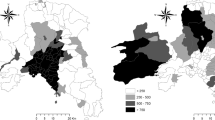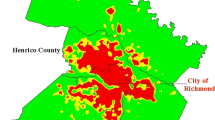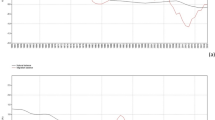Abstract
Previous urban sprawl studies have typically taken a cross-sectional approach without examining how sprawling urban areas are performing over time. Longitudinal studies of individual or household travel behavior and built-environment preference have made some progress in this direction, but very few studies have explored the longitudinal interaction of urban form with transportation and environmental outcomes. This study begins to fill this gap by evaluating the transportation and environmental impact dynamics of several key dimensions of urban sprawl: density, land use mix, centrality, and street connectivity. The central hypothesis is that while the built environment is durable and development patterns change slowly, the impacts of urban sprawl are dynamic rather than static and are accelerated in more sprawling cities relative to less sprawling cities. To test this hypothesis, a panel dataset of 7 years (2000–2007) was developed for 60 Metropolitan Statistical Areas of the US and a hybrid modeling framework that incorporates fixed and random effects is applied to evaluate different transportation and environmental outcomes over time. We found that the influence of urban centrality or the strength of urban sub-centers on the travel pattern of commuters and transit users is dynamic. This suggests that people living in cities with stronger centers drive less and use public transportation more over time. For environmental outcomes, we found that cities with higher density have experienced a significant decrease in ambient ozone and PM2.5 concentrations after controlling city-specific variables.

Similar content being viewed by others
Notes
Ewing et al. (2002) also calculated an overall sprawl score combining the four measures of sprawl, but this composite index is not used in this study.
These data can be accessed at http://tti.tamu.edu/documents/ums/congestion-data/complete-data.xls.
These data can be accessed at http://www.epa.gov/airtrends/pdfs/AirQualityTrendsbyCity2000-2012.xlsx.
References
Allison PD (2009) Fixed effects regression models. Sage Publications, Los Angeles
Bechle MJ, Millet DB, Marshall JD (2011) Effects of income and urban form on urban NO2: global evidence from satellites. Environ Sci Technol 45:4914–4919
Bereitschaft B, Debbage K (2013) Urban form, air pollution, and CO2 emissions in large U.S. metropolitan areas. Prof Geogr 65(4):612–635. doi:10.1080/00330124.2013.799991
Bhat CR, Guo JY (2007) A comprehensive analysis of built environment characteristics on household residential choice and auto ownership levels. Transp Res Part B Methodol 41(5):506–526
Borrego C, Martins H, Tchepel O, Salmim L, Monteiro A, Miranda AI (2006) How urban structure can affect city sustainability from an air quality perspective. Environ Model Softw 21:461–467
Brownstone D (2008) Key relationships between the built environment and VMT. University of California, Irvine
Brownstone D, Golob TF (2009) The impact of residential density on vehicle usage and energy consumption. J Urban Econ 65:91–98
Brueckner JK, Largey AG (2008) Social interaction and urban sprawl. J Urban Econ 64(1):18–34
Cao XY, Mokhtarian PL, Handy SL (2009) Examining the impacts of residential self-selection on travel behaviour: a focus on empirical findings. Transp Rev 29(3):359–395. doi:10.1080/01441640802539195
Carruthers JI, Ulfarsson GF (2003) Urban sprawl and the cost of public services. Environ Plan B Plan Des 30(4):503–522
Clark LP, Millet DB, Marshall JD (2011) Air quality and urban form in U.S. urban areas: evidence from regulatory monitors. Environ Sci Technol 45:7028–7035
Crane R, Chatman D (2003) Traffic and sprawl: evidence from U.S. commuting, 1985 to 1997. Plan Mark 6(1):14–22
Crane R, Chatman D (2004) Traffic and sprawl: evidence from U.S. commuting 1985–1997. In: Richardson H, Bae C (eds) Urban sprawl in Western Europe and the United States. Ashgate, London
Crane R, Crepeau R (1998) Does neighborhood design influence travel?: a behavioral analysis of travel diary and GIS data. Transp Res Part D Transp Environ 3(4):225–238
Dieleman FM, Dijst M, Burghouwt G (2002) Urban form and travel behaviour: micro-level household attributes and residential context. Urban Stud 39(3):507–527
Dubin R (1991) Commuting patterns and firm decentralization. Land Econ 67:121–129
Echenique MH, Hargreaves AJ, Mitchell G, Namdeo A (2012) Growing cities sustainably: does urban form really matter? J Am Plan Assoc 78(2):121–137
Eid J, Overman HG, Puga D, Turner MA (2008) Fat city: questioning the relationship between urban sprawl and obesity. J Urban Econ 63(2):385–404
England P, Farkas G, Kilbourne BS, Dou T (1988) Explaining occupational sex segregation and wages: findings from a model with fixed effects. Am Sociol Rev 53:544–558
EPA (2006) Greenhouse gas emissions from the U.S. transportation sector, 1990–2003. Environmental Protection Agency, Washington, DC
Ewing R (1997) Is Los Angeles-style sprawl desirable? J Am Plan Assoc 63(1):107–126
Ewing R, Rong F (2008) The impact of urban form on U.S. residential energy use. Hous Policy Debate 19(1):1–30
Ewing R, Pendall R, Chen D (2002) Measuring sprawl and its impact. Smart Growth America, Washington, DC
Ewing R, Pendall R, Chen D (2003) Measuring sprawl and its transportation impacts. Transp Res Rec 1831:175–183
Filion P, McSpurren K, Appleby B (2006) Wasted density? The impact of Toronto’s residential-density distribution policies on public-transit use and walking. Environ Plan A 38:1367–1392
Frank LD, Stone B, Bachman W (2000) Linking land use with household vehicle emissions in the central Puget Sound: methodological framework and findings. Transp Res Part D 5(3):173–196
Frank LD, Sallis JF, Conway TL, Chapman JE, Saelens BE, Bachman W (2006) Many pathways from land use to health: associations between neighborhood walk ability and active transportation, body mass index, and air quality. J Am Plan Assoc 72:75–87
Galster G, Hanson R, Ratcliffe MR, Wolman H, Coleman S, Freihage J (2001) Wrestling sprawl to the ground: defining and measuring an elusive concept. Hous Policy Debate 12(4):681–717
Gordon P, Richardson HW (1997) Are compact cities a desirable planning goal? J Am Plan Assoc 63(1):95–106
Gordon P, Kumar A, Richardson HW (1989) The influence of metropolitan spatial structure on commuting time. J Urban Econ 26:138–151
Gordon P, Richardson HW, Jun MJ (1991) The commuting paradox: evidence from the top twenty. J Am Plan Assoc 57(4):416–420
Gordon P, Lee B, Richardson HW (2004) Travel trends in U.S. cities: explaining the 2000 census commuting results. University of Southern California, Los Angeles
Grazi F, Van der Bergh JC, Van Ommeren JN (2008) An empirical analysis of urban form, transport, and global warming. Energy J 29(4):97–122
Handy S (2005) Smart growth and the transportation-land use connection: what does the research tell us? Int Reg Sci Rev 28(2):146–167
Handy SL, Clifton KJ (2001) Local shopping as a strategy for reducing automobile travel. Transportation 28:317–346
Handy S, Cao X, Mokhtarian P (2005) Correlation or causality between the built environment and travel behavior? Evidence from Northern California. Transp Res Part D 10(6):427–444
Holden E, Norland IT (2005) Three challenges for the compact city as a sustainable urban form: household consumption of energy and transport in eight residential areas in the greater Oslo region. Urban Stud 42(12):2145–2166
Hong J, Shen Q, Zhang L (2013) How do built-environment factors affect travel behavior? A spatial analysis at different geographic scales. Transportation. doi 10.1007/s11116-013-9462-9
Jacobson MZ (2008) On the causal link between carbon dioxide and air pollution mortality. Geophys Res Lett 35. doi:10.1029/2007GL031101
Jerrett MR, Buenett T, Pope CA, Ito K, Thurston G, Krewski D, Shi Y, Calle E, Thun M (2009) Long-term ozone exposure and mortality. N Engl J Med 360(11):1085–1095
Knaap GJ, Song Y, Ewing R, Clifton K (2005) Seeing the elephant: multi-disciplinary measures of urban sprawl. National Center for Smart Growth Research and Education, Urban Studies and Planning Program, University of Maryland
Laden F, Schwartz J, Speizer FE, Dockery DW (2006) Reduction in fine particulate air pollution and mortality: extended follow-up of the Harvard six cities study. Am J Respir and Crit Care Med 173(6):667–672
Lariviere I, Lafrance G (1999) Modelling the electricity consumption of cities: effect of urban density. Energy Econ 21(1):53–66
Levinson DM, Kumar A (1994) The rational relocator: why travel times have remained stable. J Am Plan Assoc 301:495–519
Levinson DM, Kumar A (1997) Density and journey to work. Growth Change 28:147–172
Liao CH, Chang CL, Su CY, Chiueh PT (2013) Correlation between land-use change and greenhouse gas emissions in urban areas. Int J Environ Sci Tech 10(6):1275–1286
Malpezzi S (1999) Estimates of the measurements and determinants of urban sprawl in US metropolitan areas. University of Wisconsin, Center for Urban Land Economics Research, Madison (unpublished paper)
Marshall JD (2008) Energy-efficient urban form. Environ Sci Technol 42(9):3133–3137
Mokhtarian PL, Cao X (2008) Examining the impacts of residential self-selection on travel behavior: a focus on methodologies. Transp Res Part B 42(3):204–228
Nelson AC, Moore T (1996) Assessing growth management policy implementation: case study of the united states’ leading growth management state. Land use Policy 13(4):241–259
Neuman M (2005) The compact city fallacy. J Plan Educ Res 25:11–26
Newman P, Kenworthy J (1989) Gasoline consumption and cities: a comparison of US cities with a global survey and its implication. J Am Plan Assoc 55(1):24–37
Niedt C, Martin IW (2013) Who are the foreclosed? A statistical portrait of America in crisis. Hous Policy Debate 23(1):159–176
Peiser R (2001) Decomposing urban sprawl. Town Plan Rev 72(3):275–298
Richmond HR (1995) Regionalism: Chicago as an American region. John D and Catherine T MacArthur Foundation, Chicago
Runhaar H, Driessen P, Soer L (2009) Sustainable urban development and the challenge of policy integration: an assessment of planning tools for integrating spatial and environmental planning in the Netherlands. Environ Plan 36(3):417–431
Sarzynski A, WomanHL Galster G, Hanson R (2006) Testing the conventional wisdom about land use and traffic congestion: the more we sprawl, the less we move? Urban Stud 43(3):601–626
Schweitzer L, Zhou J (2010) Neighborhood air quality, respiratory health, and vulnerable populations in compact and sprawled regions. J Am Plan Assoc 76(3):363–371
Song Y, Knaap G (2004) Measuring urban form: Is Portland winning the war on sprawl? J Am Plan Assoc 70(2):210–225
Stone B (2008) Urban sprawl and air quality in large US cities. J Environ Manag 86(4):688–698
Sultana S (2000) Some effects of employment centers on commuting times in the Atlanta metropolitan area, 1990. Southeast Geogr 41(2):225–233
Sultana S, Chaney P (2003) Impact of urban sprawl on travel behaviors and local watersheds in the Auburn-Opelika metropolitan area: a case study on a small MSA. Pap Proc Appl Geogr Conf 26:20–280
Sultana S, Weber J (2013) The nature of urban growth and the commuting transition: endless sprawl or a growth wave? Urban Stud. doi:10.1177/0042098013498284
The Sierra Club (1999) The dark side of the American dream: the costs and consequences of suburban sprawl. The Sierra Club, San Francisco
Torrens PM, Alberti M (2000) Measuring sprawl. Working Paper Series, Paper-27, CASA: Centre for Advanced Spatial Analysis, University College London, London
Tsai Y (2005) Quantifying urban form: compactness versus ‘sprawl’. Urban Stud 42(1):141–161
Tuzkaya U (2009) Evaluating the environmental effects of transportation modes using and integrated methodology and an application. Int J Environ Sci Technol 6(2):277–290
Wassmer R (2000) Urban sprawl in a US metropolitan area: ways to measure and a comparison of the Sacramento area to similar metropolitan areas in California and the US. CSUS Public Policy and Administration Working Paper, CA
Weber J, Sultana S (2007) Journey-to-work patterns in the age of sprawl: evidence from two midsize southern metropolitan areas. Prof Geogr 59(2):193–208
Weng Q (2003) Fractal analysis of satellite-detected urban heat island effect. Photogramm Eng Remote Sens 69(5):555–566
Yigitcanlar T, Teriman S (2014) Rethinking sustainable urban development: towards an integrated planning and development process. Int J Environ Sci Tech 1–12. doi:10.1007/s13762-013-0491-x
Zhao P, Lu B, de Roo G (2011) The impact of urban growth on commuting patterns in a restructuring city: evidence from Beijing. Pap Reg Sci 90(4):735–754
Zolnik EJ (2011) The effect of sprawl on private-vehicle commuting outcomes. Environ Plan-Part A 43(8):1875–1893. doi:10.1068/a42466
Acknowledgments
We would like to acknowledge and cordially thank the anonymous reviewers for their constructive comments and suggestions, which helped us to significantly improve the manuscript.
Author information
Authors and Affiliations
Corresponding author
Rights and permissions
About this article
Cite this article
Kashem, S.B., Irawan, A. & Wilson, B. Evaluating the dynamic impacts of urban form on transportation and environmental outcomes in US cities. Int. J. Environ. Sci. Technol. 11, 2233–2244 (2014). https://doi.org/10.1007/s13762-014-0630-z
Received:
Revised:
Accepted:
Published:
Issue Date:
DOI: https://doi.org/10.1007/s13762-014-0630-z




